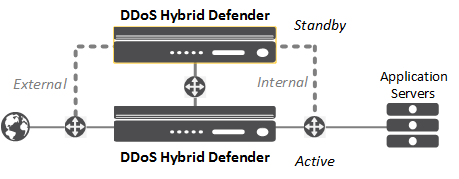Applies To:
Show Versions
F5 DDoS Hybrid Defender
- 13.1.0
Overview: Installing DDoS Hybrid Defender for High Availability
You can install DDoS Hybrid Defender™ onto a dedicated system (device 1) and set up a failover system that automatically takes over in case of system failure (device 2). The system processing traffic is called the active system. A second system is set up as a standby system, and data is synchronized between the active and standby systems. If the active system goes offline, the standby system become active, and begins processing traffic and protecting against DDOS attacks.
You can assign the management IP addresses from the LCD panel of the devices, or with a hypervisor if you are using the Virtual Edition.

DDoS Hybrid Defender High-Availability deployment
You must have two DDoS Hybrid Defender systems to set up high availability. Before you begin, make sure you have this information for both devices:
- Base registration key
- Internal and external self-IP addresses
- Management IP address, network mask, and management route IP address
- Passwords for the root and admin accounts
- NTP server IP address (optional)
- Remote DNS lookup server IP address (required for F5 Silverline® integration or if resolving host names)
Performing initial setup
If setting up two systems for high availability, you need to perform initial setup on both systems.
Manually licensing DDoS Hybrid Defender
If setting up two systems for high availability, you have to activate the license on both systems.
Connecting two DDoS Hybrid Defender devices
- Connect the two DDoS Hybrid Defender™ devices as required by your network configuration.
- Note the interfaces and VLAN used to connect the devices.
Installing DDoS Hybrid Defender on device 1
Connecting with F5 Silverline
If setting up high availability, you need to register with Silverline on both devices.
DDoS Hybrid Defender is now integrated with the Silverline Cloud Platform.
Configuring high availability on device 1
Checking the status of DDoS Hybrid Defender on device 2
Configuring the network on the high availability systems
- Use the default VLAN setup (L2 bridge mode), for example, if you use switch topology
- Use Virtual Wire (L2Wire) to set up the system as an inline L2 transparent mode device
- Define VLANs, if the system uses routed technology
- Define routes as needed to direct traffic.
Setting up remote logging
If setting up high availability, configure remote logging on the active device.
Event logs from DDoS Hybrid Defender are sent to the remote logging server in the format you specified.





